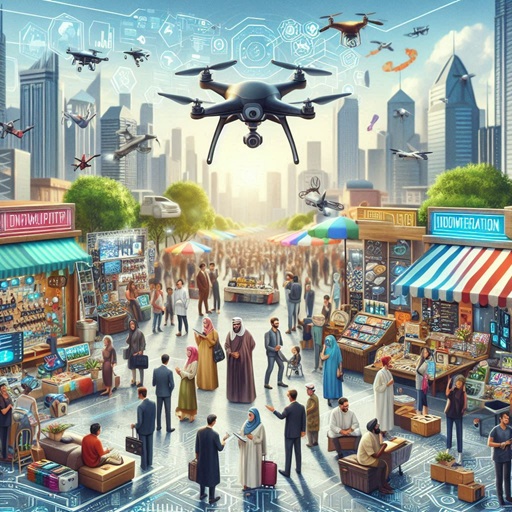The Global Anti-Drone Market Dynamics are rapidly evolving due to increasing security threats posed by unauthorized drones. Governments, military, and commercial sectors are investing heavily in counter-drone technologies to mitigate risks such as espionage, smuggling, and terrorist activities. The market is witnessing significant growth, driven by advancements in detection and neutralization systems.
Understanding the Global Anti-Drone Market Dynamics is crucial for stakeholders to make informed decisions. This article delves into the market’s key drivers, challenges, segmentation, and future outlook while maintaining a strong focus on emerging trends and competitive landscape.
Key Drivers Shaping the Global Anti-Drone Market Dynamics
Rising Security Concerns and Unauthorized Drone Activities
The surge in unauthorized drone usage has amplified security concerns worldwide. Incidents of drones breaching restricted airspace near airports, military bases, and critical infrastructure have led to stringent regulations. Governments are increasingly adopting anti-drone systems to prevent potential threats, fueling the Global Anti-Drone Market Dynamics.
Technological Advancements in Detection and Mitigation Systems
Innovations in radar, radio frequency (RF) scanners, and artificial intelligence (AI) have revolutionized drone detection. Modern anti-drone systems employ machine learning for real-time threat assessment, enhancing their efficiency. These technological advancements play a pivotal role in shaping the Global Anti-Drone Market Dynamics.
Increasing Military and Defense Expenditure
Military forces worldwide are prioritizing anti-drone solutions to counter adversarial drone threats. The integration of laser-based and kinetic energy systems in defense strategies is accelerating market growth. The defense sector remains a dominant contributor to the Global Anti-Drone Market Dynamics.
Regulatory Support and Government Initiatives
Governments are implementing strict policies to regulate drone operations, mandating the deployment of counter-drone measures. Initiatives like the FAA’s Remote ID rule in the U.S. and similar regulations in Europe are driving market expansion. Such regulatory frameworks are a critical component of the Global Anti-Drone Market Dynamics.
Expanding Horizons: The Rapid Growth of the Global Anti-Drone Market
The global anti-drone market size has demonstrated remarkable expansion, with its valuation reaching USD 2.16 billion in 2024. Industry analysts project an accelerated growth curve, estimating the market to surge to USD 7.05 billion by 2029. This growth represents a compound annual growth rate (CAGR) of 26.7% over the forecast period from 2024 to 2029, underscoring the increasing demand for advanced counter-drone solutions worldwide.
Market Segmentation in Global Anti-Drone Market Dynamics
By Technology
The Global Anti-Drone Market Dynamics can be segmented based on technology into detection systems (radar, RF, electro-optical) and mitigation systems (jamming, interception, laser). Detection systems dominate due to their early threat identification capabilities.
By Application
Key applications include military & defense, commercial, and homeland security. The military segment leads due to high-security requirements, while the commercial sector is growing with the rise in drone-related incidents at public events.
By Region
North America holds the largest market share, driven by strong defense budgets and technological advancements. Meanwhile, Asia-Pacific is emerging as a high-growth region due to increasing security threats and government investments.
Challenges Impacting the Global Anti-Drone Market Dynamics
High Costs of Advanced Anti-Drone Systems
Developing and deploying sophisticated counter-drone technologies involves substantial costs, limiting adoption among small and medium enterprises. This financial barrier is a significant challenge in the Global Anti-Drone Market Dynamics.
Legal and Ethical Concerns
The use of anti-drone systems raises privacy and regulatory concerns, particularly in civilian areas. Governments must balance security needs with ethical considerations, impacting market growth.
Evolving Drone Technologies
As drones become more advanced with stealth and AI capabilities, anti-drone systems must continuously upgrade, posing a challenge for manufacturers.
Future Trends in Global Anti-Drone Market Dynamics
Integration of AI and Machine Learning
AI-powered anti-drone systems will enhance threat prediction and response times, making them indispensable in security operations.
Development of Non-Kinetic Solutions
Non-lethal methods like signal jamming and spoofing will gain traction due to their minimal collateral damage.
Expansion in Commercial and Public Safety Sectors
Stadiums, airports, and critical infrastructure will increasingly adopt anti-drone solutions, broadening market opportunities.
The Global Anti-Drone Market Dynamics are shaped by technological innovation, regulatory support, and increasing security threats. While challenges like high costs and legal concerns persist, advancements in AI and non-lethal solutions offer promising growth opportunities. Stakeholders must stay ahead of emerging trends to capitalize on this rapidly evolving market.
FAQs on Global Anti-Drone Market Dynamics
What are the primary drivers of the Global Anti-Drone Market Dynamics?
Key drivers include rising security threats, technological advancements, and increasing military expenditure.
Which region dominates the Global Anti-Drone Market Dynamics?
North America leads due to high defense spending, while Asia-Pacific is the fastest-growing region.
What are the major challenges in the anti-drone market?
High costs, legal concerns, and evolving drone technologies are significant hurdles.
How is AI influencing the Global Anti-Drone Market Dynamics?
AI enhances detection accuracy and response efficiency, making anti-drone systems more effective.
What future trends will shape the anti-drone market?
AI integration, non-kinetic solutions, and commercial sector expansion are key future trends.


